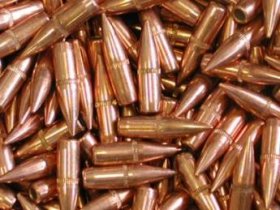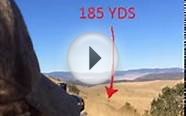30-06 for Elk hunting
 Let's do the impossible-right now-by deciding on the very best bullet for your next big-game hunt. To set the scene, let's say it's the western hunt you've dreamed of for years, and it is only a month away. You have a glistening new rifle in .30/06 caliber and you've topped it off with the best scope money can buy. All that remains are a few practice sessions at the local shooting range and sighting-in your new '06 so precisely that you'll be dead on target when that big bull elk steps out of the timber.
Let's do the impossible-right now-by deciding on the very best bullet for your next big-game hunt. To set the scene, let's say it's the western hunt you've dreamed of for years, and it is only a month away. You have a glistening new rifle in .30/06 caliber and you've topped it off with the best scope money can buy. All that remains are a few practice sessions at the local shooting range and sighting-in your new '06 so precisely that you'll be dead on target when that big bull elk steps out of the timber.
So you stop by a gun shop for some ammo and sight-in sessions and the dealer hits you with a question you weren't ready for: "What weight bullets do you want?"
"Oh, I dunno, " you stumble in response. "Whatever it takes for elk. The outfitter guiding me said the .30/06 would be a good all-purpose caliber for the elk, antelope and mule deer we'll be hunting, but he didn't say anything about bullets. Just gimme the best bullets you've got."
"Look mister, all my bullets are good, but I got six different weights in .30/06, from 125-grain all the way to 220-grain, so name your poison."
What the heck, elk are big critters, probably the heaviest bullet will be best.
Bigger is always better-or is it? "Bigger is best" was the military way of thinking just a little over a hundred years ago when the .30/40 cartridge was adopted as the official U.S. Army round. Before that, it had been the thunderous .45/70, which heaved a 405-grain slug. Thus with the "downsizing" from .45 to .30 caliber, a 220-grain bullet was decided on for the new round, and my guess is that many of the brass hats, some of whom were Civil War veterans, considered the little bullet downright puny and marginal for military purposes.
Such thinking was shattered by volleys of light-but-deadly bullets during our war with Spain, in which the fast-firing, flat-shooting 7mm Mauser bolt rifles were about the only thing Spanish troops had going for them. Veterans of that war long remembered the crack and whiz of the 173-grain Spanish bullets (the 700 Spanish defenders of San Juan hill inflicted twice their number in casualties), and the U.S. Military decided, at last, to catch up with the rest of the world in terms of small arms and ammo. That led to the development and adoption of the now legendary 1903 Springfield rifle and, in 1906, the .30/06 cartridge. (A "redheaded stepson" on the .30-caliber family tree known as the .30/03 was the army's choice for three years preceding the .30/06. It too was loaded with 220-grain bullets, reflecting the maxim that old habits die hard.)
The new .30/06 military round was loaded with pointed 150-grain bullets (the earlier 220-grain slugs were round-nosed) loaded to a snappy 2, 700 feet per second, and the world hasn't been the same since. If you're wondering what this slice of military history has to do with your elk hunt, the purpose is to give you some idea of how tradition affects even modern-day bullet selection. Like those one-legged Civil War veterans of a century ago who steadfastly maintained that heavier is better, there is a small (and growing smaller) army of hunters who stubbornly cling to the notion that a 220-grain bullet from their .30/06 shoots harder, busts brush better and kills deader than any lighter bullets ever will.
The truth is that most 220-grain bullets have very few redeeming features when loaded in the .30/06. To begin with, it starts out too slow (about 2, 400 fps at the muzzle) and gets a lot slower in a hurry because the round nose doesn't drill through the atmosphere as efficiently as a pointed bullet. Somewhere in dim history a rumor got started that round-nosed bullets penetrate brush better than the pointy types. Whoever thought up that one was in need of a cold shower, because round-nosed bullets with big patches of exposed lead at the tip-I call 'em ice cream cones-are about the worst possible choice for hunting in brus Picture a bowling ball made of putty and you'll get the idea.
A few years back I got a call from a big ammo company asking if I could explain why they sold so much .30/06 ammo with 220-grain bullets in a two- or three-county area not far from where I live. I told him I had no idea, but when I checked it out I discovered that "shooting" fish was legal and popular in a river that ran through those counties. Apparently the locals felt that the heavier bullets created more fish-stunning concussion and, if so, the old 220-grain slug has a redeeming quality after all.
Don't get me wrong, I'm not against heavy bullets. For example, of the various bullets I load in my .338 Win. Mag., I stoutly maintain that a 250-grain-the heaviest bullet commonly available-is by far the best choice. After all, that's what the .338 Mag. is all about. Anyone who favors lighter slugs just hasn't been eye-to-eye with a grizzly.
You might also like



|
Rifle Sporting Firearms Journal September 2008 Magazine No. 239 INSIDE REMINGTON'S CUSTOM SHOP School Days: Holland's Long-Range Academy PLAINS RIFLE: RUGER No. 1 .30-06 COMMEMORATIVE Book (Don Polacek) |









